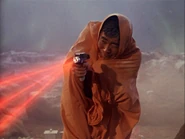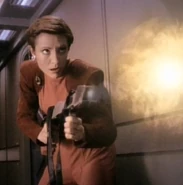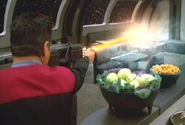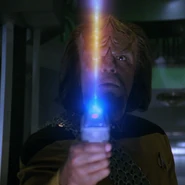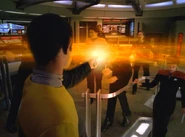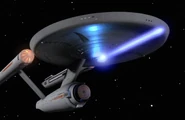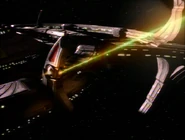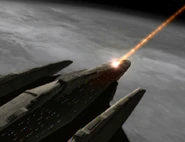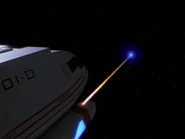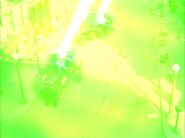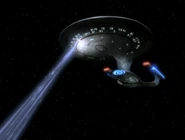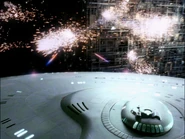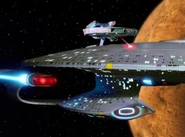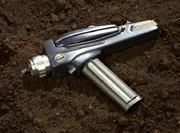
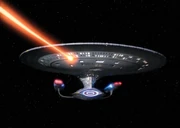
"It's my first ray gun."
Phasers were the most common and standard directed energy weapon in the arsenal of Starfleet and several other powers. Most phasers were classified as particle weapons and fired directed energy nadion particles, (Star Trek: First Contact; TNG: "The Mind's Eye"; VOY: "Time and Again", "Demon") but some like the Ferengi hand phaser were classified as plasma weapons and fired nadions in the form of forced plasma energy. (TNG: "Descent") Based on the intensity, field of fire, and a variety of adjustments, a wide variety of effects could be achieved such as the ability to stun, kill, or vaporize a target, as well as setting a shot's size to be narrow or wide.
History

22nd century - phase technology
Phaser technology was initially preceded by phase-modulated particle weapons in the mid-22nd century. Though a much more primitive version of phaser technology, phase technology was versatile and able to have a small number of new effects over previous technology, such as being able to stun targets. Phase weapons were standard aboard United Earth Starfleet and used in a multitude of situations: ship-mounted phase cannon and hand-held phase-pistols. (Star Trek: Enterprise, all;) Laser weapons, such as the laser pistol, were also used before phasers became the standard-issue weapon in the Starfleet arsenal. (TOS: "The Cage")

Laser weaponry
After the United Federation of Planets was formed, Starfleet abandoned phase weapons in favor of more traditional lasers, which were more powerful and reliable. Despite being more rigid, lasers over the past centuries had increased in power. An example of this is now being able to vaporize their target on one of the highest settings (TOS: "What Are Little Girls Made Of?"). Lasers were used both aboard the ship and on the ground as laser cannons for starships and laser pistols for personnel. (TOS: "The cage")
The introduction of Phasers
Phaser weaponry was invented by Starfleet during the 23rd century and was a vast improvement on the original phase technology from which it was derived (TNG: "A Matter Of Time"). A combination of phase and laser technology, phasers had the combination of versatility, flexibility, and power. The technology began being used by Starfleet as early as 2233; though it was still experimental and not too common. Some ships such as the USS Kelvin were equipped and tested with experimental ship-mounted phaser banks (Star Trek). While laser technology continued to be utilized for the first half of the 23rd century, the transition began at the halfway mark. Still in use by 2254, Starfleet slowly began replacing lasers with phasers. Most personnel had been equipped with phaser weapons by 2256, the new small arms having 3 different variants: The Type 1 hand phaser which was the weakest but most concealable, the Type 2 Phaser pistol which was the most versatile and the "standard" one used, and the Type 3 Phaser rifle which was the bulkiest but most powerful and capable of self-recharging. On Starships, replacing directed energy weapons took more time, and the process was nearly halted in 2256, as the Federation-Klingon war took off and forced Starfleet to rely on ship laser weapons due to them being more widely available and made the process of getting starships back to the front lines faster after construction and repairs. After the war, Starfleet began fleet-wide upgrades of most starships, continuing into 2259, and by that point, the majority of the fleet had been upgraded to phaser weapons. (TOS: "The Cage"; DIS: "The Vucan Hello", "Such Sweet Sorrow part 2"; SNW: "Strange New Worlds")

On Deneb V, in 2268, death by phaser was one method of execution for those who were given the death penalty. (TOS: "I, Mudd")
In 2269, starship bridges were defended by an automatic bridge defense system programmed to defend the ship from capture. (TAS: "Beyond the Farthest Star")
In the 2270s, phaser power systems of Federation starships were redesigned to channel power directly from the warp core, thereby increasing the power output of phaser banks. If the ship goes to warp and experiences antimatter imbalance or gets trapped in a wormhole or a subspace rift phasers will not work until the ship has cleared the distortion and the wormhole effect has dissipated. (Star Trek: The Motion Picture)
23rd-century Starfleet phasers became inoperative from exposure to the radiation emanating from 20th century nuclear fission reactors, even if said reactors were safely shielded for Humans. (Star Trek IV: The Voyage Home)
The 24th century saw many new advanced forms of phaser weaponry for the Federation, such as the ever more powerful phaser arrays that made use of multiple phaser emitter segments, the rapid-fire phaser cannons and new compression phaser rifles. (Star Trek: The Next Generation, all; DS9: "The Search, Part I"; VOY: "Caretaker") As a historical note, the regenerative phaser was chosen instead of the TR-116 for development. (DS9: "Field of Fire")
In the 29th century, phaser pistols were still used by Starfleet, (VOY: "Relativity") but subatomic disruptors were used on timeships, such as the Aeon, as a ship-mounted directed energy weapon. (VOY: "Future's End")
Descriptions and uses
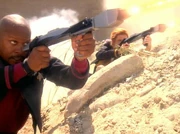
Phasers typically fired shots that could stun, heat, kill, or disintegrate living creatures, though they could fire bolts using the proximity blast function as well. Phasers could damage shields or other systems or even cut through a hull. Phasers could also be used to cut through walls and burrow through rock. The beam could be focused on a single spot or widened to impact a large area.
In the nadion particle beam phasers, plasma was passed to a phaser emitter resulting in a discharge of nadion particles. Residual particles could be found in places where a battle had recently taken place. The disruptive effects of nadion discharges were moderated to produce varying effects (discussed below), ranging from benign to extremely destructive. (VOY: "Phage", "Memorial", "Endgame")
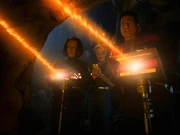
The Starfleet-issue personnel phasers came in three types: The phaser type-1 (hand phaser) was small and could be concealed easily. The type 2 phaser was larger and hand-held. It had a longer hand grip or a pistol grip, depending on the model. The phaser type-3 was also known as the phaser rifle. It had a longer barrel, a stock, and some models had a second grip. Over the centuries of use, there have been several models of these weapon types. (TOS: "The Devil in the Dark"; TNG: "The Mind's Eye")
Beyond these types, phasers were usually mounted devices, such as the type 4 phaser emitters, which were sometimes used on Starfleet shuttlecraft, all the way up to the large phaser banks and phaser arrays of starships and space stations. Various types of banks, arrays, and emitters existed, such as the more powerful phaser type-8 and the phaser cannon. (TNG: "The Outcast", "Preemptive Strike"; VOY: "Live Fast and Prosper")

Hand-held phasers were also used by Starfleet personnel as tools and not just weapons. The phaser could be used to heat rocks and stones for warmth. (TOS: "The Enemy Within", "A Private Little War", "Spock's Brain"; TNG: "Final Mission"; VOY: "Parturition"; DS9: "Rocks and Shoals") While there were specialized tools like phaser bores and phaser drills, (TAS: "Once Upon a Planet"; VOY: "Once Upon a Time") Worf once used his type-2 phaser to open a tunnel on the Cardassian planet Celtris III. (TNG: "Chain Of Command, Part I") A phaser, when fired together with another in tandem or set to a high setting could create an opening in a solid rock wall. (VOY: "Caretaker"; DS9: "Rapture"; Star Trek: Insurrection) Hand phasers were used to clean carbon filters by scraping off the build-up of carbon, (LD: "Moist Vessel") and with the right setting could even do something as mundane as removing graffiti off of a bulkhead. (LD: "Temporal Edict")
Different models of phasers made different sounds when fired, depending on the model and setting. Federation phaser fire typically made a high-pitched "whistling" or "tearing" sound, for example. A knowledgeable person could use the sound to differentiate between types and power settings. (TOS: "Errand of Mercy"; TNG: "Too Short A Season"; DS9: "Sacrifice of Angels")

In the alternate reality created by Nero's temporal incursion, hand phasers of the late 2250s emitted concentrated bolts of phaser energy rather than the steady streams generated by phasers of the prime reality.

In addition, these phasers had a rotating nozzle that flipped when set from stun to kill or vice versa. The ship-mounted phaser banks aboard the USS Enterprise were also used to fire bolts resembling proximity blasts. (Star Trek)
The advanced phaser weaponry of the USS Vengeance included emitters capable of firing powerful arcing phaser blasts. (Star Trek Into Darkness)

Bajoran phaser rifles were used by the Bajoran Militia, based on the design of their own hand phasers. (DS9: "The Way of the Warrior") Regalian phaser rifles were less powerful than their Starfleet counterparts. (TNG: "The Vengeance Factor") The phaser used by Tolian Soran in 2371 fired concentrated bolts of phaser energy. (Star Trek Generations)
While phasers were powerful weapons, they also had limitations. Phasers did not affect neutronium alloys or the dikironium cloud creature. (TOS: "The Doomsday Machine", "Obsession") The creature known as Armus even seemed to be able to feed off of phaser blasts. (TNG: "Skin Of Evil") In 2369, two type-2 hand phasers at maximum level were unable to penetrate the toranium inlays of Cardassian doors. Major Kira Nerys recommended a bipolar torch to be used to cut through the door. (DS9: "The Forsaken")
Hand phasers could be made to overload, either deliberately or by sabotage. Phasers in the process of overloading emitted a distinctive high-pitched whine. The weapon released all of its energy in an explosion capable of doing considerable damage to its surroundings. In 2266, Lenore Karidian attempted to murder James T. Kirk by hiding an overloading phaser in his cabin. (TOS: "The Conscience of the King") In 2269, Kirk, McCoy, and Sulu were almost killed while on the Kalandan outpost planet, when its defensive computer fused the controls on Kirk's phaser, causing it to overload. (TOS: "That Which Survives")
Modifications
Personnel phasers were normally set to fire a single steady stream of nadion particles. This beam could be widened to perform a phaser sweep. Most types of phasers could be set to alternatively fire a concentrated bolt of phaser energy. In addition, a personnel phaser could be set to fire a spread of multiple beams at once, a field burst of a specific frequency, a luvetric pulse, or an expanding energy pulse. (TOS: "The Enemy Within"; TNG: "Time's Arrow, Part II", "Descent"; DS9: "The Way of the Warrior", "The Adversary")
Phasers could also be set to fire a single nadion bolt of energy as well. (DIS: "The Vulcan Hello")
Phasers had an adjustable resonance frequency. When modified, the color of the beam changed. Borg systems were vulnerable to a frequency spread in the high narrow band, but compensated for the weakness after Locutus was assimilated in 2366. (TNG: "The Best of Both Worlds") In 2367, the phaser adapter was designed, a chip that automatically re-tuned the phaser to a random setting after each discharge. Using the adapter, phasers were set on a rotating modulation to allow at most twelve shots to penetrate Borg shielding before they adapted. (TNG: "The Best of Both Worlds, Part II"; Star Trek: First Contact; VOY: "Scorpion")
Phasers could be reconfigured to fire a low-intensity burst which would not cause damage to a spacecraft's hull and would also not affect a hull resiliency evaluation's test procedure. (TNG: "Lower Decks")
Hand phasers also had an adjustable dispersion frequency measured in gigahertz and they could be set for specific phase variances. These allowed the phaser beam to impact targets that were phased or interphased. (VOY: "Distant Origin", "Scientific Method") A phaser's setting could be modified to disrupt a hologram's holo-matrix. (VOY: "Renaissance Man")
Like the transporters and sensors, hand-held and starship-mounted phasers were also inoperative in areas with high levels of hyperonic radiation, because the phaser beams were randomized by the radiation. To compensate, it was possible to modify a phaser with a servo circuit that continuously recollimated the output. Neural subprocessors of Soong-type androids could be utilized as these servos. (TNG: "The Ensigns of Command")
Starship-mounted phasers were normally set to fire steady streams. They could also be set to fire concentrated bolts of phaser energy that detonated at a specific point in space known as proximity blasts. In addition to the powerful settings, the ship's phasers also had a stun setting that could be used to render lifeforms unconscious when fired at a planetary surface from orbit. (TOS: "Balance of Terror", "The Trouble with Tribbles", "A Piece of the Action")
It was possible to configure starship phasers to also fire energy beams for power transfer, antimatter spreads, laser pulse beams, photon pulses, pulse compression waves, modulating phaser pulses, and covariant phaser pulses. (TNG: "Encounter at Farpoint", "Sub Rosa", "Peak Performance", "The Best of Both Worlds, Part II", "The Outcast"; DS9: "Emissary"; VOY: "Dark Frontier", "Parturition")
Sidearm settings
The 23rd and 24th-century personal phasers included several settings.
- Setting number one is also called the base cycle stunning force. (TOS: "The Enemy Within") This minimal setting caused only a stun effect on the average humanoid lifeform. A hit would leave the target dazed and unable to stand or think straight for a short time. (TOS: "The Man Trap") When used at close range, a phaser set on stun was still capable of inducing sufficient trauma to kill a Human if fired at a vital organ such as the brain. (Star Trek VI: The Undiscovered Country) However, even several hits on stun had very little effect on an Augment, though only by hitting the torso, while a shot to the head would be enough to knock them out for less than a minute. (Star Trek Into Darkness) Two phasers set on setting one fired simultaneously could break large objects into pieces, such as the urns of the second planet of the Taurean system. (TAS: "The Lorelei Signal")
- Setting 3.1 was enough to cause a Changeling to experience the stun effect. Setting 3.4 or 3.5 was determined to be a stun setting that would effectively stun and force any Changeling to revert back into the gelatinous state. (DS9: "Homefront") A wide-field stun setting was used when large groups needed to be stunned with a single shot. (TOS: "The Return of the Archons") Some stun settings could also cause unconsciousness. Although mostly harmless when used at these low settings, multiple phaser stuns like this could result in injury and death. (TNG: "Samaritan Snare") There was a heavy stun force setting and a maximum stun setting also known as full stun charge. (TOS: "Tomorrow is Yesterday"; TNG: "Legacy"; TAS: "The Eye of the Beholder") The highest stun setting was strong enough to immobilize a Soong-type android. (TNG: "A Matter Of Time")

- A phaser could be used as a heat beam, to heat a variety of substances, such as rocks or even coffee. (TOS: "The Enemy Within", "The Corbomite Maneuver", "Spock's Brain") Phasers could be set to inflict non-lethal second-degree burns. (VOY: "Worst Case Scenario") Settings 6 and 7 caused severe burns in the flesh of humanoids. (TNG: "Night Terrors") Setting 7 was also powerful enough to vaporize noranium carbide. (TNG: "The Vengeance Factor") Phasers could be used to melt certain ores from solid to liquid. (TNG: "The Enemy") They could also be used to quickly boil through tens of meters of ice. (TAS: "The Slaver Weapon")
- One-quarter, force 3 and level 10 were different names for the kill setting on a hand phaser. (TOS: "The Man Trap", "Operation -- Annihilate!"; TNG: "Aquiel") The kill setting on hand phasers used by the Mordanites had a distinct sound from the stun setting. (TNG: "Too Short A Season") To a humanoid infected by a parasitic being, the kill setting only caused unconsciousness, due to the high levels of adrenaline in the target's body. However, extended exposure to a body part such as the head of a humanoid would cause it to explosively vaporize. Two phasers set to kill could also disintegrate smaller lifeforms such as the neural parasite mother creature with extended exposure. (TNG: "Conspiracy") The kill setting was also non-lethal to the flying parasites that invaded Deneva in 2267. Because each parasite was part of a huge organism and drew strength from that organism, it could largely resist force 3. Parasites exposed for five to ten seconds reacted as if mildly stunned; they fell from the surface to which they were attached, and did not react to external stimuli for about a minute. (TOS: "Operation -- Annihilate!") Firing a phaser on kill at point-blank range against an Andorian can cause phase pulse infection and at higher frequencies it can also kill them. (ENT:"Babel One")
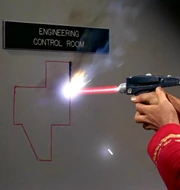
- Cutting settings could be used to slice off segments of a steelplast wall, (TNG: "Too Short A Season") a standard Starfleet corridor wall, (TOS: "The Naked Time", "The Way to Eden") or even to slice off body parts. (Star Trek VI: The Undiscovered Country)
- The normal maximum setting on a hand phaser would vaporize a humanoid lifeform or a Human-size android with a single hit. (TOS: "What Are Little Girls Made Of?"; TOS: "Mirror, Mirror"; TNG: "The Vengeance Factor"; Star Trek: First Contact) This was also called disintegration. (ENT: "In a Mirror, Darkly, Part II") When used as a means of suicide, the phaser would also disintegrate along with the person shooting at himself. (TOS: "Elaan of Troyius") There was also a maximum setting that could set parts of clothing or humanoids on fire. (TNG: "Datalore", "The Wounded") Against a Horta, even when set specifically for silicon, the maximum setting would only hurt the creature. (TOS: "The Devil in the Dark") Disruptor-B was another maximum setting for the type 2 phaser. It was also called the disruptor effect setting. This setting was assessed to be the most effective against gaseous dikironium. (TOS: "Obsession") According to Valeris, and demonstrated to Mr. Chekov, a phaser fired on a setting of vaporize aboard a starship releases so much energy that it will trigger a security alarm. (Star Trek VI: The Undiscovered Country)
- The standard level 16 setting on a type 2 phaser could be used to vaporize tunnels through rock large enough to crawl through. (TNG: "Chain Of Command, Part I") The level 16 wide-field setting could easily destroy half of a large building with a single shot. (TNG: "Frame of Mind") However, there were materials phasers couldn't cut through even at this maximum level, such as toranium (DS9: "The Forsaken") and the unknown material used to create the Hotel Royale on Theta VIII. (TNG: "The Royale")
Types of phaser weapons
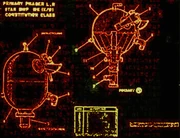

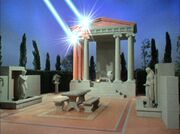
There were several numbered types of phasers of increasing size and capability: types 1, 2, and 3 were personnel phasers, and types 4 and above were ship-mounted weapons. The phasers mounted aboard starships were considerably more powerful than those used by Starfleet personnel, owing to the increased power reserves available. Early phasers, such as the MK IX/01 type found on the USS Enterprise, were mounted in banks of one or two emitters.
Hand-held phasers
- A type 1 phaser was a small, concealable sidearm weapon
- A type 2 phaser was a larger sidearm weapon, which evolved from a pistol-styled design
- A type 3 phaser was a rifle-sized weapon
These main types and technologies were further classified to distinguish the many variations.
- Hand phaser
- Ferengi phaser
- Phaser bazooka (possibly fictional)
- Phaser pistol
- Bajoran phaser
- Cardassian phaser
- Klingon phaser
- Kzinti phaser
- Vulcan phaser
- Phaser rifle
- Plasma phaser – a proposed anti-Borg weapon
- Regenerative phaser
Planetary or starship-mounted phasers
- Class 3 defensive – used on Miranda-class supply ships
- Particle phaser – used on transport ships from Boreal III
- Phaser bank
- Phaser array
- Phaser battery
- Phaser cannon – used on Defiant-class starships
- Type 4 phaser emitter – used on Type 6 shuttlecraft
- Phaser type-8 – used on Excelsior-class starships
- Galor-class phaser bank
| Phaser technology |
|---|
| Tools: phaser bore • phaser drill |
| Weapons: Automatic bridge defense system • Bajoran phaser • Bajoran phaser rifle • compression phaser rifle • Ferengi hand phaser • Galor-class phaser bank • hand phaser • Kzinti phaser • particle phaser • phaser array • phaser bank • phaser cannon • phaser emitter • phaser pulse • phaser type-1 • phaser type-2 • phaser type-3 • phaser type-4 • phaser type-8 • plasma phaser • Regalian phaser rifle • regenerative phaser |
| Other: phaser adapter • phaser coil • phaser coolant • phaser coupling • phaser range • phaser relay • phaser room • phaser station • phaser sweep |
Appendices
See also
References
Background information
Gene Roddenberry had some problems with the look of hand-held phasers. "He didn't want the phasers to look like guns," explained Production Designer Herman Zimmerman, "with handles and trigger guards and triggers [....] But he didn't do that on the classic series and they didn't do it in the features, which Gene had very little to do with; they used pistol grips and rifles, and Gene was never happy with any of that." (Star Trek: The Magazine Volume 2, Issue 12, p. 24)
According to Ben Burtt, for the Original Series, "the steady blast of the phaser was derived from the hovering sound of the Martian war machines made for the 1953 version of Paramount's War of the Worlds. The original was made with tape feedback of an electric guitar and a harp." For Star Trek, Burtt said, "the steady sound just wasn't the right way to go because the visuals are so different, so I made something that recalls it, but features a Doppler effect and is shorter and sharper. My sounds were added to those that had already been supplied by Mark P. Stoeckinger and Alan Rankin". Stoeckinger stated that "Harry Cohen made tonal sounds with a concussive element that served what the phaser was doing along with adding a version of that neo-classical space phone-like element that Ben Burtt provided to give the phaser roots in the franchise along with adapting it for the current film." [12] [13]
Establishing phaser technology
According to the unauthorized 2013 reference book These Are the Voyages: TOS Season One, (p. 40) the term phaser was originally invented as a mash-up of the words photon and maser.
During The Original Series, the mechanics of phasers were never explained on screen. However, as early as the release of The Making of Star Trek in 1968, the technology behind phasers was explained. Phasers are, according to the book, basically lasers, but they have the beam set on a pulsating frequency that can be specifically set to interfere and interact with the wave pattern of any molecular form. This is called "phasing" the beam frequency, hence the name phaser.
According to Gene Roddenberry in The Making of Star Trek, two days into the filming of the second pilot, they realized that three years later, people were going to say, "Oh, come on, lasers can't do that." The term was consequently substituted, based on the idea of the phasing principle of physics, which is a way of increasing power. Roddenberry was talking about using higher phase velocities (aka frequencies) of light that, in turn, consist of higher energy photons. These accounts suggest that the laser weapons seen in "The Cage" and phasers of the rest of the show were possibly just two different terms for the same thing.
Released in 1979, the Spaceflight Chronology (p. 173) offers an alternative explanation of the technology. It states that phaser weapons were developed by Starfleet to combine the benefits of two previously used weapon technologies: particle-beam cannons and laser banks. While particle weapons delivered a big punch, they had trouble penetrating shields, whereas lasers penetrated shielding easily, but had very little impact force to do damage. Two years after the events of "The Cage", when the problem with frequency aligning the two systems to work simultaneously in ship-mounted phasers was solved, the development of hand phasers began. This timeline for phaser development would, however, not be compatible with canonical accounts, as we saw ship-mounted phasers used by the USS Kelvin in the 2009 film Star Trek, over twenty years before the events of "The Cage".
According to the 1990 Star Trek: The Next Generation Writers' Technical Manual (Fourth season edition, p. 14), the term "phaser" is short for "phased array emitter".
The 1991 reference book Star Trek: The Next Generation Technical Manual (pp. 123-125) explains the inner mechanisms of a phaser in more elaborate detail. "Phaser" is, according to the book, an acronym for "phased energy rectification" – named for the process of turning stored energy into an energy beam without an intermediate transformation. Energetic plasma is pumped to a prefire chamber made out of superconducting lithium copper. There, it undergoes a rapid nadion effect in which strong nuclear forces are liberated. A protonic charge forms and is released in pulses to the emitter made out of the same superconductive crystal. A beam of electromagnetic energy is released from it, at the speed of light. On starships, energy for phasers originates from the EPS, while on hand units, the charge of energetic plasma is stored in sarium-krellide. This material is used because it can't accidentally release the charge of plasma.
Dialogue in the 1991 episode TNG: "The Mind's Eye" concerning the internal mechanics of a type 3 phaser rifle confirms, canonically, all the elements as they were established in the Manual. However, in Star Trek, phasers have been regularly used while starships travel at warp speeds, so the beam must also be traveling at faster-than-light velocities. Beginning with the 1993 episode TNG: "Inheritance", instead of being labeled as EM weapons, as the reference works have stated, phasers have been consistently referred to as particle beam weapons on screen. This information was also included in the 1994 Star Trek: Voyager Technical Manual – Writer's Guide, and has been corroborated in Star Trek: First Contact and such episodes as "Time and Again", "Memorial", and "Endgame".
Even though the phaser beam was canonically established as not a beam of pure EM energy but a particle beam of nadions, the 1998 reference book Star Trek: Deep Space Nine Technical Manual still goes on to describe the phaser beam as an EM energy beam. According to page 84 of the Manual, a phaser beam can be delivered at warp speeds due to an annular confinement beam jacket and other advances in subspace technology. These are stated to be new inventions in the late-24th century. However, considering that the first on-screen uses of phasers at warp occurred as early as the first season of The Original Series, this timeline for the invention would be inconsistent with canon. Furthermore, according to page 92 of the Manual, when phasers are fired by a ship with deflector shields active, the beam is frequency locked to the second-order harmonics of the shield emissions. This prevents the beam from impacting on the shields and overloading them, or rebounding back at the firing ship.
It is not known what class of Federation starships was the first to use phaser array strips instead of banks, but "Yesterday's Enterprise" establishes the Ambassador-class to be the earliest known ship design to employ them in the 2340s.
Recalling how the phasers in Star Trek: Discovery were designed, Aaron Harberts described them as "super-important [...] key props" that "nobody wanted to really change." [14]
Phaser settings
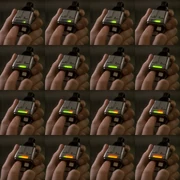
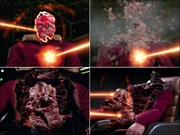
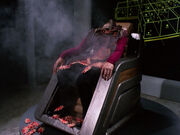
The Star Trek: The Next Generation Technical Manual (pages 135 – 137) and The Star Trek Book (citation needed • edit) list various settings for type 1, type 2, and type 3 phasers, some of which have not been mentioned on screen and some which have been given a different effect. Type 1 phasers had the first eight settings; type 2 and 3 phasers had all sixteen settings.
- Light Stun – causes central nervous system impairment in humanoids, unconsciousness for up to five minutes. Long exposure to several shots causes reversible neural damage.
- Medium Stun – causes unconsciousness from five to fifteen minutes. Long exposure causes irreversible neural damage, along with damage to epithelial tissue.
- Heavy Stun – causes unconsciousness from fifteen to sixty minutes depending on the level of biological resistance. Significantly heats metals.
- Thermal Effects – causes extensive neural damage to humanoids and skin burns limited to the outer layers. Causes metals to retain heat when applied for over five seconds.
- Thermal Effects – causes severe outer layer skin burns. Can penetrate simple personal force fields after five seconds of application.
- Disruption Effects – penetrates organic and structural materials. The thermal damage level decreases from this level onward.
- Disruption Effects – due to widespread disruption effects, kills humanoids.
- Disruption Effects – causes a cascade disruption that vaporizes humanoid organisms. Any unprotected material can be penetrated.
- Disruption Effects – causes medium alloys and structural materials, over a meter thick, to exhibit energy rebound before vaporization.
- Disruption Effects – causes heavy alloys and structural materials to absorb or rebound energy. There is a 0.55-second delay before the material vaporizes.
- Explosive/Disruption Effects – causes ultra-dense alloys and structural materials to absorb or rebound energy before vaporization. There is a 0.2-second delay before the material vaporizes. Approximately ten cubic meters of rock are disintegrated per shot.
- Explosive/Disruption Effects – causes ultra-dense alloys and structural materials to absorb or rebound energy before vaporization. There is a 0.1-second delay before the material vaporizes. Approximately fifty cubic meters of rock are disintegrated per shot.
- Explosive/Disruption Effects – causes shielded matter to exhibit minor vibrational heating effects. Approximately 90 cubic meters of rock are disintegrated per shot.
- Explosive/Disruption Effects – causes shielded matter to exhibit medium vibrational heating effects. Approximately 160 cubic meters of rock are disintegrated per shot.
- Explosive/Disruption Effects – causes shielded matter to exhibit major vibrational heating effects. Approximately 370 cubic meters of rock are disintegrated per shot.
- Explosive/Disruption Effects – causes shielded matter to exhibit light mechanical fracturing damage. Approximately 650 cubic meters of rock are disintegrated per shot.
The Star Fleet Technical Manual gives the effective ranges for different settings. On the type 1 phaser, they were: stun – thirty meters, heat – two meters, disrupt – twenty meters, dematerialization – ten meters. On the type 2 phaser, the ranges were: stun – ninety meters, heat – six meters, disrupt – sixty meters, dematerialization – thirty meters. Setting dials on the hand phasers indicated nine settings on the type 1 phaser and fifteen on the type 2 phaser, of which all above ten were labeled by the letters A through E. The letters might be a reference to the disruptor-B setting mentioned in "Obsession", which would make it setting 10B. According to Mr. Scott's Guide to the Enterprise, the hand phasers used during the first four movies had only three preset levels: stun, disrupt, and dematerialize.
Commenting on phaser firepower, Ronald D. Moore said: "The weapons are way too powerful to present them in any realistic kind of way. Given the real power of a hand phaser, we shouldn't be able to show ANY firefights on camera where the opponents are even in sight of each other, much less around the corner! It's annoying, but just one of those things that we tend to slide by in order to concentrate on telling a dramatic and interesting story." (AOL chat, 1997)
The relative power of phasers was also referenced on-screen in TOS: "Bread and Circuses", when Proconsul Claudius Marcus of the planet 892-IV stated that it was his understanding that one hundred men armed with phasers could probably defeat the combined armies of his entire empire. The natives on 892-IV were at the time armed with machine guns and early 20th century level technology.
Other types of starship phasers
- Type V phaser was used on auxiliary craft. In Star Trek: The Next Generation Technical Manual it was stated that Type 7 shuttlecrafts and type 9A cargo shuttles used phaser emitters of this type during special operations. According to Star Trek: Starship Spotter the Chaffee shuttlepod and the Delta Flyer also used this phaser type.
- Type VI phaser was used on auxiliary craft and runabouts. According to the Star Trek: Starship Spotter, the Aeroshuttle and Danube-class starships phaser arrays were of this type.
- Type VII phaser was used on starships. According to the Star Trek: Deep Space Nine Technical Manual and Star Trek: Starship Spotter, the twin phaser banks on Miranda-class starships were of this type.
- Type IX phaser is used on starships. According to the Star Trek: Deep Space Nine Technical Manual, the Ambassador-class, Centaur-type, Curry-type, and one type of Excelsior-class variant used them. The phaser emitters in the rotary weapon arrays of the weapon sail towers of Deep Space 9 were of this type.
- Type X phaser was used on starships. According to Star Trek: The Next Generation Technical Manual, this was the type name of the phaser arrays used on the Galaxy-class starships. According to the Star Trek: Deep Space Nine Technical Manual the Akira-class, Norway-class, Nebula-class, Saber-class, Soyuz-class, and one type of Constitution-class variant also used them. The fixed phaser emitters in the weapon sail towers of Deep Space 9 were of this type. According to Star Trek: Starship Spotter, the Intrepid-class and Nova-class also used them.
- Type X+ phaser was used for planetary defense. According to Star Trek: The Next Generation Technical Manual, this was the designation of some large dedicated planetary phaser defense emitters.
- Type XI phaser was normally used for planetary defense. According to the Star Trek: Deep Space Nine Technical Manual', the emitters were designed to minimize atmospheric blooming of the beam. The phaser emitters in the carriages, embedded into the habitat ring of Deep Space 9, were of this type, modified for use in space.
- Type XII phaser was used on starships. According to Star Trek: Starship Spotter this is the type designation of the phaser cannons of the Defiant-class starships and the standard beam phaser arrays of the Prometheus-class and Sovereign-class starships.
None of these type of designations have been mentioned on screen.
External links
- Phaser at Memory Beta, the wiki for licensed Star Trek works
- Phasers.net
